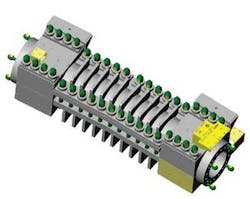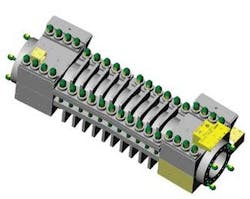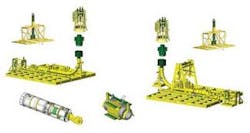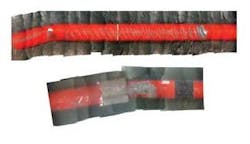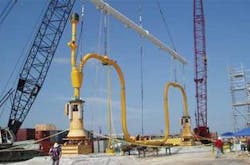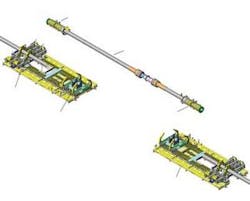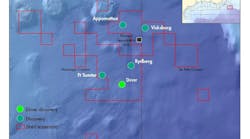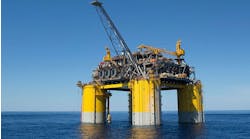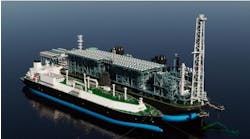Bo Povloski, Oil States Industries Inc.
In the Gulf of Mexico in 2005, Hurricane Katrina forced a mobile offshore drilling unit (MODU) off station, dragging an anchor across the Shell-operated Mars and Ursa fields’ export lines, resulting in significant damage and leading to a world first deepwater diverless spool piece repair using mechanical connector systems.
As the need to repair deepwater pipelines becomes more frequent, especially in the hurricane-prone GoM, a repair system has been developed to mitigate the potential for long-term production loss. The system consists of capital equipment and prepared procedures for the repair of pre-identified assets, thus minimizing the repair time and production downtime. Three types of repairs methods are discussed below: clamp, on-bottom, and surface-lift.
Clamp-type repairs are for minor defects that may cause pinhole leaks, localized corrosion attack, weld defects, or for local reinforcement of damaged pipe. These consist of standard straight clamps or custom formed designs.
On-bottom repairs are for major pipeline damage, usually when a clamp is unable to be installed or the damaged area is significant in size. There are two types of on-bottom repair: vertical and horizontal. Vertical consists of two gooseneck spool pieces connected to the cut end of the pipe and a vertical jumper to connect the two ends. A horizontal system consists of two telescoping connectors on each end of the jumper. Once the jumper is set, the two end connectors telescope across the pipe ends to grip and seal.
On-surface repairs require lifting the damaged pipeline then welding on a pipeline end termination (PLET) to each end of the cut pipeline. The PLETs then are lowered back to the bottom and then a vertical jumper is installed to complete the connection.
null
Deepwater risk
The investment in deepwater pipelines represents tens of billions of dollars in direct costs and hundreds of billions in revenue. The value of deepwater pipeline networks will steadily increase as more deepwater projects come online. There are more than 32,000 mi (51,499 km) of pipelines in the GoM and 70,000 mi (112,654 km) of offshore pipelines worldwide.
Deepwater pipelines not only are susceptible to damage during a storm, but also many potential risks exist during their operational life. The risk to a deepwater pipeline is significant in three main phases: installation, commissioning, and operation. During the operation phase is when the most likely potential for damage or failure can occur. Possible causes are anchor snag, thermal buckling, dropped objects, mudslides, hydrate formations, and corrosion induced leakage.
Inline equipment failure of valves, flanges, test ports, PLETs, pipeline end manifolds (PLEMs), and manifolds can result from vibration and corrosion.
Not all potential risks to a pipeline can be prevented, but the impact of the event can be mitigated by having a repair plan and the equipment in place to reduce down time and production loss.
Damage types
Minor damage such as external scoring may require only a clamp repair. This can be used to repair damage that is generally one pipe diameter long. The clamps are split half shells with longitudinal seals on the split face and circumferential seals on the ends. The clamps can be sealing or full structural. Sealing clamps protect for wall defects or reinforce thinning pipe wall areas. Full structural design includes internal grips, which provide full pipe separation support.
Major pipe damage requiring the section to be cut out and replaced, can be done in two ways – with on-bottom repair or surface-lift repair. On-bottom repair involves the remote installation of a Grip and Seal Hydraulic Connector (GSHC) attached to a spool with an upward looking male hub. This is connected to each end of the pipeline and provides the facility for a standard collet connector vertical jumper installation. The surface-lift repair involves recovering the pipeline to the surface, welding on a bend-hub assembly together with a sled or PLET, and then laying the sled down with an upward-looking male hub for vertical jumper installation.
Deepwater repair system
BP and Shell have developed a Deepwater Pipeline Repair System (DPRS) to provide three repair methods: clamp, on-bottom, and surface-lift. These are used for both minor and major pipeline damage. Minor damage is localized and extends over a length of pipe equal to or less than one pipe diameter. Major damage is greater than one pipe diameter.
The repair system includes a pipe lift frame to lift sections of pipeline above the seabed to allow ROV access to the section of pipe to be repaired. It also holds the pipe steady during the operation. The lift frame grabs the pipe with interchangeable clamps with vertical lift and lateral traverse capability. All functions are powered by standard ROV hydraulics. A GSHC is used to connect an elbow with male hub assembly to the pipeline ends. It is installed remotely from the gantry sled by an ROV following pipe preparation. The GSHC can be converted into a pipeline recovery tool if needed. Collet connectors are used to connect the vertical jumper. Running tools are used to land the jumper and latch the connector. The repair spool has the GSHC on one end and a 90º bend with an upward-facing male hub on the other end. The gantry sled is custom designed to install the repair spool onto the end of a prepared subsea pipeline. It is installed onto an alignment frame that is landed on the pipeline. The sled, powered and controlled by an ROV, functions much like a bridge crane, with XYZ translation and rotational movement capabilities.
The DPRS system requires ROV tooling for pipe preparation for the GSHC connector. Some of the equipment includes diamond wire pipe cutting tools, pipe-end deburring tools, coating removal tools, and weld seam removal tools. These are required for the GSHC to function and to be installed correctly.
Mars, Ursa repairs
Hurricane Katrina forced a MODU off station, dragging an anchor across the Mars and Ursa export lines, resulting in significant damage. The Ursa lines will be repaired with Diverless HydroClamps.
The 18-in. (457-mm) oil line was fitted with a standard one diameter HydroClamp from an existing Shell deepwater pipeline repair kit. The 20-in. (508-mm) gas line requires a custom-built clamp to match the bent profile.
The Mars export pipelines (18-in. [46-cm] oil and 14-in. [36-cm] gas) both were cracked where the anchor made contact. Preparations began for an on-bottom spool piece replacement in each line. Shell had developed a DPRS a number of years ago. The system was the precursor to the BP Mardi Gras DPRS. The Shell kit was much smaller based on their pipeline coverage of 12-20-in. (30.5-58-cm) ANSI 900, while BP’s covered 16-28-in. (40.6-71-cm) ANSI 1500.
Components from the original system were taken out of storage in Morgan City and shipped to Houston for System Integration Testing (SIT) and pre-deployment preparations. The ice-breaker vesselBotnica was contracted for the repair operation. The vessel was equipped with a 160-metric ton (176-ton) passive heave-compensated crane, two ROV spreads, and adequate deck space to accommodate the repair equipment.
Gantry frames to transfer connector assemblies onto the prepared pipe ends were refurbished. Weldments containing a pipeline end connector and an upward looking hub connection structure for a collet connector were fabricated in 18- and 14-in. (46- and 35.5-cm) line sizes. System testing was completed for the ROV tooling associated with pipe cutting and end prepping to ensure it would function properly with the deployed ROV spread. Tooling was developed for work associated with flushing the lines to remove the oil and gas prior to taking out the damaged sections. A temporary clamp assembly was developed for the oil and gas lines. To mitigate the possibility of oil escaping the temporary clamp, a pollution dome (16.5 ft [5 m] wide x 20 ft [6 m] long with approximately 650 bbl of working capacity) was fabricated and positioned over the clamp. Returns from the top of the dome were routed to a subsea hydraulically-powered pump, which then transferred fluids via coiled tubing to a surface oil spill response vessel. A spring buoy system was deployed at the repair site to moor the response vessel while it received returns from the pollution dome pump. A flushing procedure was developed for each line so all hydrocarbons could be evacuated from the top of the TLP riser past the crack site approximately 6.5 mi (10.5 km) from the structure.
Flushing started once theBotnica arrived. Oil line flushing was done in two phases: 1) a high velocity flush for 1,700 bbl to ensure turbulent flow and to push the oil/seawater interface past the riser touchdown point, and 2) a low velocity flush of 17,000 bbl to displace the oil past the crack site. The high velocity flush was required to keep the flow turbulent allowing the associated oil/water interface to remain intact. The lower velocity flush used gravity displacement to move the oil past the crack. The low velocity flush resulted in less oil leaking into the pollution dome, allowing the pumping system to keep up with the total volume entering the dome. A total of 3,200 bbl of crude oil and 1,300 bbl of seawater were pumped from the dome through the coiled tubing unit up to the responder vessel.
The two ends of the pipeline were lifted and relocated closer to their original installation coordinates. Next, the pipe end was cut with a diamond wire saw, the pipe end deburred, a slight external bevel placed on the pipe, and the epoxy-based external coating was removed. The sled was deployed from surface, indexed at the appropriate distance, axial-aligned to the pipe end, and set in final position.
The weldment then was transferred onto the pipe end, and the grip and seal system was engaged on the pipeline end connector. The subsequent annulus seal test on the connector was 2,400 psi for one hour. The connector then was secured to the sled, the rigging removed, and the gantry frame retrieved to the surface. The same process was used on the other three sled ends. Once the sleds were set and the connectors were actuated, acoustic measurements were taken to determine the offset distance between the two upward-looking hubs along with the angular differences.
The jumpers, designed with a wye for future tie-in, were pre-fabricated in Houston and final welding was completed in Fourchon. Upon completion of jumper SIT, they were loaded onto a supply vessel, transported offshore, lifted directly off the vessel, lowered to the seabed, installed, and pressure tested in four days.
New generation
Oil States Industries has launched a new generation repair method. It is a horizontal system that uses the low profile end solution to minimize future snags. The horizontal system replaces the vertical collet connector, upward-facing repair spool, and gantry, to transfer the repair spool and the large vertical m-style jumper with a smaller telescoping Dual Grip & Seal (DGS) hydraulic connector on shorter horizontal jumpers. The connector is the same connector that was used onMars, but is provided back-to-back. Also, the horizontal jumper has a similar installation method as the vertical repair jumper. Lift frames are lowered to manipulate the pipeline, and the damaged pipe section is cut out and removed. An indexing/alignment base is installed on the free pipe end. Next, metrology is taken and a repair jumper is fabricated and installed. The telescoping DGS is deployed on the repair jumper with a set of hydraulic cylinders that push the outer DGS connector onto the free cut end of the pipe. The ROV activates the connector with a single hydraulic function, which grips and seals the connector onto the pipeline. An annulus and hydro test is done, and the pipeline is ready for product.
The DGS connector was selected for the new Shell Deepwater Horizontal Repair System, Girasol Water Injection Repair, Deepwater RUPE Repair System, and Chevron Petronius Repair System.
About the author
Bo Povloski is a technical sales specialist with Oil States Houston operations, where he has served for more than 10 years. He has 20 years of technical subsea pipeline and deepwater experience. This includes working as a team leader for the critical deepwater repair systems following hurricanes Ivan, Katrina, and Rita.
